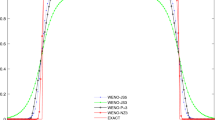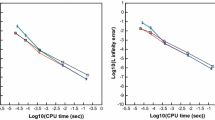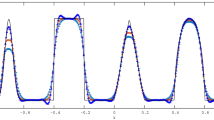Abstract
In this work we introduce fifth-order weighted essentially non-oscillatory (WENO) scheme using new global smoothness indicator which demonstrates improved numerical results compared to the solutions obtained using the fifth order WENO-JS schemes. The proposed scheme achieves an optimal level of approximation, even at critical points where both the first and second derivatives vanishes, but not the third derivative. Numerical examples are presented in the subsequent section to check the robustness and accuracy of the proposed scheme for one and two-dimensional systems of hyperbolic equations.








Similar content being viewed by others
Data availability
No data is used.
References
Harten, Ami. 1997. High resolution schemes for hyperbolic conservation laws. Journal of Computational Physics 135 (2): 260–278.
Harten, Ami, Stanley Osher, Björn. Engquist, and Sukumar R. Chakravarthy. 1986. Some results on uniformly high-order accurate essentially nonoscillatory schemes. Applied Numerical Mathematics 2 (35): 347–377.
Harten, Ami, Bjorn Engquist, Stanley Osher, and Chakravarthy., and Sukumar R. 1987. Uniformly high order accurate essentially non-oscillatory schemes III. Journal of Computational Physics 71 (2): 231–303.
Harten, Ami, Bjorn Engquist, Stanley Osher, and Sukumar R. Chakravarthy. 1997. Uniformly high order accurate essentially non-oscillatory schemes, III, 190–218. Berlin Heidelberg: Springer.
Balsara, Dinshaw S., and Chi-Wang. Shu. 2000. Monotonicity preserving weighted essentially non-oscillatory schemes with increasingly high order of accuracy. Journal of Computational Physics 160 (2): 405–452.
Jiang, Guang-Shan., and Chi-Wang. Shu. 1996. Efficient implementation of weighted eno schemes. Journal of Computational Physics 126 (1): 202–228.
LeVeque, Randall J. et al. Finite volume methods for hyperbolic problems, volume 31. Cambridge university press, 2002.
Shu, Chi-Wang. 2009. High order weighted essentially nonoscillatory schemes for convection dominated problems. SIAM Review 51 (1): 82–126.
Shu, Chi-Wang. Essentially non-oscillatory and weighted essentially non-oscillatory schemes for hyperbolic conservation laws. Technical report NASA/CR-97-206253, NAS 1.26:206253, ICASE-97-65, Institute for computer applications in science and engineering; Hampton, VA United States, 1997.
Shu, Chi-Wang. Essentially non-oscillatory and weighted essentially non-oscillatory schemes for hyperbolic conservation laws. In Advanced numerical approximation of nonlinear hyperbolic equations, 325–432. Springer, 1998.
Shu, Chi-Wang., and Stanley Osher. 1988. Efficient implementation of essentially non-oscillatory shock-capturing schemes. Journal of Computational Physics 77 (2): 439–471.
Shu, Chi-Wang., and Stanley Osher. 1989. Efficient implementation of essentially non-oscillatory shock-capturing schemes, II shock-capturing schemes. Journal of Computational Physics 83 (1): 32–78.
Liu, Xu-Dong., Stanley Osher, and Tony Chan. 1994. Weighted essentially non-oscillatory schemes. Journal of Computational Physics 115 (1): 200–212.
Toro, Eleuterio F. Riemann solvers and numerical methods for fluid dynamics: a practical introduction. Springer Science & Business Media, 2013.
Gottlieb, S., and C.-W. Shu. 1998. Total variation diminishing runge-kutta schemes. Mathematics of Computation 67 (221): 73–85. https://doi.org/10.1090/S0025-5718-98-00913-2.
Sweby, Peter K. 1984. High resolution schemes using flux limiters for hyperbolic conservation laws. SIAM journal on numerical analysis 21 (5): 995–1011.
Dubey, Ritesh Kumar. 2013. Flux limited schemes: their classification and accuracy based on total variation stability regions. Applied Mathematics and Computation 224: 325–336.
Lax, P.D. 1954. Weak solutions of nonlinear hyperbolic equations and their numerical computation. Communications on pure and applied mathematics 7 (1): 159–93.
Woodward, Paul, and Phillip Colella. 1984. The numerical simulation of two-dimensional fluid flow with strong shocks. Journal of computational physics 54 (1): 115–173.
Schulz-Rinne, Carsten W., James P. Collins, and Harland M. Glaz. 1993. Numerical solution of the Riemann problem for two-dimensional gas dynamics. SIAM Journal on Scientific Computing 14 (6): 1394–1414.
San, Omer, and Kursat Kara. 2015. Evaluation of Riemann flux solvers for WENO reconstruction schemes Kelvin-Helmholtz instability. Computers Fluids 117: 24–41.
San, Omer, and Kursat Kara. 1984. High resolution schemes and the entropy condition. SIAM Journal on Numerical Analysis 21 (5): 955–984.
Harten, Ami A. 1984. new smoothness indicator for improving the weighted essentially non-oscillatory scheme. SIAM Journal on Numerical Analysis 21 (1): 1–23.
Fan, Ping, Yiqing Shen, Baolin Tian, and Chao Yang. 2014. On a class of high resolution total-variation-stable finite-difference schemes. Journal of Computational Physics 269: 329–354.
Castro, Marcos, Bruno Costa, and Wai Don. 2014. Sun High order weighted essentially non-oscillatory WENO-Z schemes for hyperbolic conservation laws. Journal of Computational Physics 269: 329–354.
Fan, Ping. 2014. High order weighted essentially nonoscillatory WENO-\(\eta\) schemes for hyperbolic conservation laws. Journal of Computational Physics 269: 355–385.
Hu, Fuxing, Rong Wang, and Xueyong Chen. 2016. A modified fifth-order WENOZ method for hyperbolic conservation laws. Journal of Computational and Applied Mathematics 303: 56–68.
Acker, F., and Borges, RB de R., Costa, Bruno. 2016. An improved WENO-Z scheme.Journal of Computational Physics. 313: 726–753
Borges, Rafael, Monique Carmona, Bruno Costa, and Wai Don. 2008. Sun An improved weighted essentially non-oscillatory scheme for hyperbolic conservation laws. Journal of computational physics 227 (6): 3191–3211.
Henrick, Andrew K., Tariq D. Aslam, and Joseph M. Powers. 2005. Mapped weighted essentially non-oscillatory schemes: achieving optimal order near critical points. Journal of Computational Physics 207 (2): 542–567.
Biswas, Biswarup, and Ritesh Kumar Dubey. 2020. ENO and WENO schemes using arc-length based smoothness measurement critical points. Computers & Mathematics with Applications 80 (12): 2780–2795.
Pandey, Prashant Kumar, Farzad Ismail, and Ritesh Kumar Dubey. 2022. High-resolution WENO schemes using local variation-based smoothness indicator. Computational and Applied Mathematics 41 (5): 208.
Funding
Author Ritesh Kumar Dubey acknowledge the SERB India project fund through file number CRG/2022/002659.
Author information
Authors and Affiliations
Corresponding author
Ethics declarations
Conflicts of interest
Authors certify that there is no actual or potential conflict of interest in relation to this article.
Additional information
Communicated by Dhirendra Bahuguna.
Publisher's Note
Springer Nature remains neutral with regard to jurisdictional claims in published maps and institutional affiliations.
Rights and permissions
Springer Nature or its licensor (e.g. a society or other partner) holds exclusive rights to this article under a publishing agreement with the author(s) or other rightsholder(s); author self-archiving of the accepted manuscript version of this article is solely governed by the terms of such publishing agreement and applicable law.
About this article
Cite this article
Jayswal, V.K., Dubey, R.K. A new global smoothness indicator of fifth order weighted non-oscillatory scheme for hyperbolic conservation laws. J Anal (2024). https://doi.org/10.1007/s41478-024-00739-y
Received:
Accepted:
Published:
DOI: https://doi.org/10.1007/s41478-024-00739-y




